Colin Sephton's Blog
October 5, 2025
Shadowslayers Review 3: The Book of Echoes, Secrets, and a Fractured Fate
We���re excited to welcome Colin Sephton back to the blog to discuss his latest novel, Shadowslayers From the Chronicles of the Charon. Following the award-winning Timeslayers, this second volume dives deeper into a fractured cosmos where myths and machines collide. At its centre lies a mysterious and terrifying relic, the Book of Shadows, a tome that tempts, corrupts, and threatens to reshape existence itself. In this guest post, Colin explores how this forbidden book drives the story and what it reveals about the dangers of knowledge pursued without balance.
Fantasy often turns on artefacts of immense power, a sword that crowns kings, a jewel that curses empires, or a relic that decides wars. In Colin Sephton���s Shadowslayers, From the Chronicles of the Charon, the most dangerous object is not forged of steel but bound in mystery: the Book of Shadows. This enigmatic tome emerges as both promise and threat, carrying within it the weight of gods, the burden of knowledge, and the fate of worlds already cracked apart.
More than parchment or spell craft, the Book of Shadows is alive with menace. To touch it is to risk not only one���s life, but the balance of existence itself.
Origins Wrapped in DarknessWhere the Book of Consciousness symbolised creation and the fragile thread of cosmic order, the Book of Shadows carries the opposite energy: secrecy, vengeance, and unraveling. Whispers say it has drifted between planes for centuries, hidden by enchantments that resist discovery . Unlike any earthly manuscript, its words are not meant to be catalogued or studied. They are traps for the unprepared, riddles meant to consume the one who dares read them.
Its presence in Shadowslayers is less about enlightenment than temptation. It is not the voice of wisdom but the shadow of ruin.
Indigo���s Encounter and the Threat of SkotoThe first mention of the Book comes not from scholars but from assassins. Indigo Gemstone���s kidnapping by the sinister twins Skoto reveals the tome���s central role in the fractured cosmos . To them, Indigo is not merely a Union Jack agent, she is a key. They claim she holds the path to Rahu, the name they give the Book of Shadows. Their obsession is not knowledge for growth, but knowledge as a weapon.
Through Indigo���s ordeal, Sephton makes the danger clear: this is not a book of enlightenment but of manipulation. Those who seek it serve masters that hunger for destruction.
Shadows of Obsession and DesperationThe Book of Shadows tempts in different ways than its predecessor. For the obsessed, it promises ultimate power; for the desperate, it offers escape. In both cases, the result is ruin. Skoto���s violent devotion to its recovery mirrors humanity���s oldest pattern: the pursuit of forbidden secrets even when warnings abound. If Timeslayers showed us how Skye���s desperation unleashed the Charon, Shadowslayers warns us that new players, driven by ambition or survival, are always ready to repeat the same mistakes.
Knowledge as Weapon, Not WisdomUnlike a cannon or sonic blaster, the Book of Shadows does not destroy directly. Instead, it corrupts. It multiplies fear, fractures truth, and binds its reader to the will of darker forces. In a city where steam machines already stretch the limits of human control, the Book of Shadows is a reminder that the greatest danger is not always mechanical. It is ideological. It reshapes the mind before it reshapes the world.
This makes it more powerful than any invention Ignatius could engineer, for its reach lies not in gears or sound, but in human belief itself.
What the Book of Shadows Means for ReadersSephton does not present the Book of Shadows as mere decoration, it is a mirror. Humanity���s history is filled with quests for knowledge that brought both brilliance and devastation: fire, steam, electricity, nuclear power. Every breakthrough asks the same question: What will you do with me? The Book of Shadows becomes the latest embodiment of that question. Will it be used to heal the fractured cosmos, or to plunge it into eternal ruin?
For readers, the lesson is timeless: knowledge cannot be separated from responsibility. The shadows we summon through reckless pursuit may multiply until they consume us.
Conclusion: A Tome of Temptation, A Tale of WarningAt the heart of Shadowslayers lies a paradox: knowledge promises power, but in the wrong hands it becomes poison. The Book of Shadows embodies this tension. For Skoto, it is destiny. For Indigo, it is a threat she must resist. For the cosmos, it may be the final fracture that decides whether light survives at all.
Through this enigmatic tome, Colin Sephton gives us more than an artefact of fantasy. He offers a cautionary tale about the pursuit of secrets too heavy to bear. Books can illuminate, but they can also devour. And in a fractured world where shadows multiply, even a single page may change everything.
Amazon LinkSeptember 20, 2025
Shadowslayers Review 2: Unlock An Intriguing Journey Through Darkness, What holds the Power
Colin Sephton���s Shadowslayers, from the Chronicles of the Charon, continues the saga that began with Timeslayers. This is no simple sequel. Where the first novel awakened the Charon and cracked open the mysteries of the Book of Consciousness, Shadowslayers asks a darker, more urgent question: what happens when shadows multiply without end?
It is a story that blends myth and steampunk science with human struggle, showing how gods, machines, and choices shape not only worlds but also the people who dare to walk between them.
The Splintered Sky and the Fate of the CosmosThe novel opens on a world already scarred. The sky above Oxford splinters like cracked glass, each shard reflecting echoes of the Sun . This haunting image sets the tone for the book: reality itself has fractured, and every decision now ripples across infinite versions of existence. Unlike typical fantasy that relies on prophecy, Sephton explores what happens when fate itself fractures and when humans must navigate a cosmos that no longer obeys its own rules.
The Book of Shadows: A New, Forbidden QuestIf the Book of Consciousness was the heart of Timeslayers, in Shadowslayers the looming mystery is the Book of Shadows. Whispers of it haunt Indigo���s kidnappers, the eerie twins known as Skoto. Unlike its predecessor, this book does not promise knowledge alone; it promises destruction, vengeance, and fire. For the characters, the search for this tome becomes more than a quest; it becomes a test of who they are and what they are willing to unleash.
Indigo, Ignatius, and the War WithinThe cosmic struggle in Shadowslayers feels intimate because it is always tied to human frailty. Ignatius faces visions, time glitches, and inventions that edge closer to madness. His sonic experiments show the triumph of science, but also its fragility when pointed at the fabric of reality itself.
Indigo Gemstone is tested by despair. Kidnapped, betrayed, and nearly broken, she struggles to find meaning in a universe that suddenly feels endless and indifferent. Yet her strength and her refusal to yield prove that courage is not the absence of fear but the decision to rise again.
Skoto, the twin shadows, embody chaos itself: fractured beings born of the cosmos���s split. They remind us that once darkness is multiplied, it cannot easily be contained.
Through them, Sephton shows that the war between gods and mortals is always fought first inside the human heart.
Myths and Machines CollidingLike its predecessor, Shadowslayers thrives in the tension between myth and machinery. On one side are cosmic beings, enchanted tomes, and gods who toy with existence. On the other side are steam gurnies, dirigibles, and Ignatius���s invention of a sonic blaster. The brilliance of Sephton���s storytelling lies in how neither side feels secondary.
Myths bleed into science, and machines hum with almost divine resonance. The question is not whether humans should choose myth or machine but whether they can survive both at once.
What Shadowslayers Teaches UsBeneath the cosmic imagery and steampunk inventions lies a story that resonates beyond its pages. Shadowslayers is not only about battling gods or decoding forbidden books. It is about the cost of knowledge pursued without balance, the struggle to remain human in a fractured world, and the shadows we create when ambition overtakes wisdom.
For readers today, these themes feel strikingly modern. In a time when technology evolves faster than wisdom, Shadowslayers reminds us that invention without responsibility is as dangerous as any mythic curse.
A Darker, Richer Chapter in a Modern SagaShadowslayers cements Colin Sephton���s saga as one of the most original blends of fantasy and steampunk in recent years. By weaving the Charon���s haunting presence, the menace of the Book of Shadows, and the resilience of Indigo and Ignatius into a single tale, he gives us a story that is both thrilling and thought-provoking.
For fans of fantasy, sci-fi, or steampunk, this novel is more than an adventure; it is a mirror held up to our own world, asking what we unleash when we chase power at any cost.
Because in Sephton���s universe, shadows do not vanish when defeated. They multiply. And the choice of whether light can survive belongs, as always, to us.
Amazon LinkSeptember 11, 2025
Shadowslayers: Virtual Book Tour 2025 – More Secrets of the Trilogy revealed
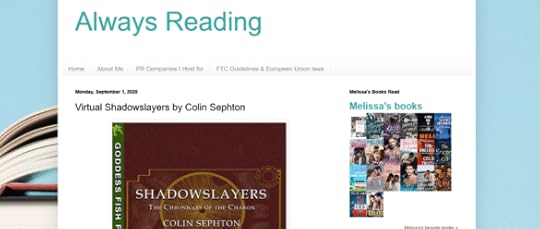 2nd September 2025
2nd September 2025
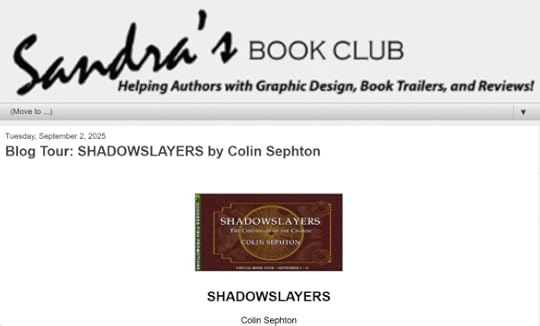 3rd September 2025
3rd September 2025
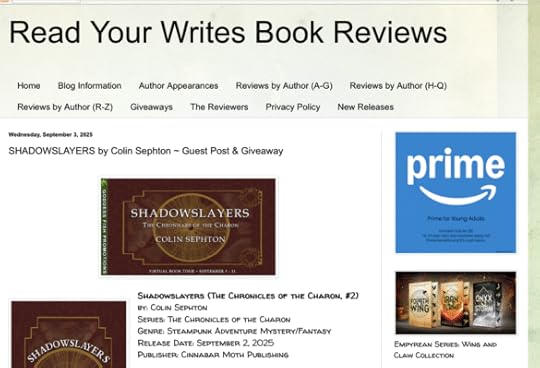 4th September 2025
4th September 2025
 5th September 2025
5th September 2025https://magickofbooks.blogspot.com/2025/09/Shadowslayers-09-05-25-VBT-GF.html?zx=a1856ad21212a7ab
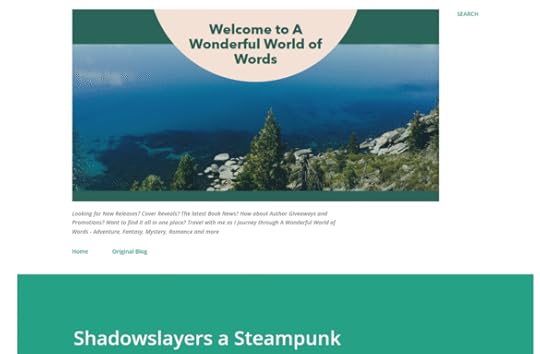 8th September 2025
8th September 2025
 9th September 2025
9th September 2025
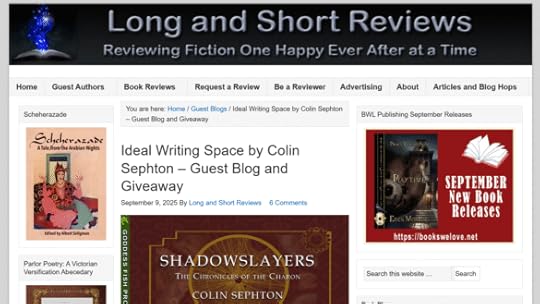 10th September 2025
10th September 2025

 11th September 2025
11th September 2025
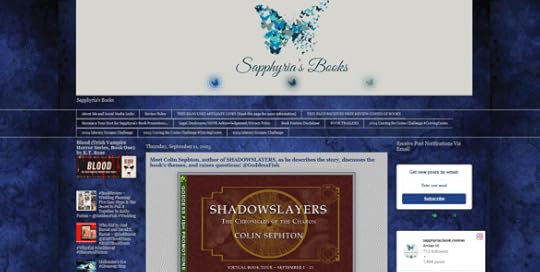 12th September 2025
12th September 2025
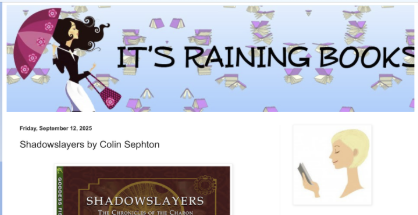
September 3, 2025
Shadowslayers Review 1: This Thrilling Adventure Belongs on Your Reading List
In this shadowslayers review, we meet the Union Jacks once more and explore the intricacies of their darkest adventure against unforgiving cosmic forces. This review highlights the importance of understanding the deeper themes within the narrative.
Ignatius and the Weight of KnowledgeFor readers who loved the mix of invention and mystery in Timeslayers, Ignatius returns as both brilliant and haunted. His experiments with sound and resonance lead him to develop a weapon unlike anything seen before. However, every breakthrough feels like a gamble with sanity.
He is still the man of science, but after glimpsing gods and travelling the cosmos, he carries the kind of knowledge that no laboratory can contain. Watching Ignatius wrestle with invention, obsession, and visions of cosmic collapse is both thrilling and unsettling, a reminder that progress often comes with a price.
His journey through the cosmos in the first book has left scars, visions, time glitches, and an awareness of realities beyond human comprehension. His tinkering with sonic weaponry and experiments with resonance reveal both brilliance and obsession.
Ignatius embodies the theme that knowledge is never neutral. Every discovery is a double-edged blade, capable of defending humanity yet also opening doors to chaos. Through this Shadowslayers review, Indigo���s character is further explored and praised.
Indigo Gemstone: The Warrior in Fractured WorldsIf Ignatius grapples with ideas, Indigo must fight for survival. In this instalment, she is ambushed, kidnapped, and forced into confrontation with Skoto, duplicitous twins born of the splintered cosmos. Indigo���s resilience is tested not just physically but existentially.
She questions the meaning of duty, yet her determination to rise again, armed and unyielding, confirms her as the saga���s core of strength. Indigo represents humanity���s ability to resist gods and demons alike, not with omniscience, but with willpower, strategy, and sheer endurance.
Indigo���s strength isn���t just physical. Readers see her shaken by despair, questioning her role, and even wondering if the fight is worth continuing. And yet she rises again, weapon in hand, mind sharpened, ready to face both gods and men.
For many readers, Indigo will stand out as the series��� emotional core: resilient, flawed, and unyielding. This Shadowslayers review underscores the implications of the Union Jacks’ actions and captures the essence of the conflict between myth and reality.
Skoto and the Multiplication of ShadowsThe human element in this Shadowslayers review truly resonates with readers. Where the first novel gave us Skye���s tragic curse, Shadowslayers introduces Skoto, duplicating, taunting embodiments of the chaos unleashed when time fractured.
They accuse Indigo of murder, hint at masters more terrible than themselves, and reveal the existence of the Book of Shadows. Their presence deepens Sephton���s recurring theme: that power, once unleashed, breeds echoes, copies, and distortions.
Just as the cosmos has split into shards, so too has opposition multiplied. Shadows are no longer singular; they are legion.
The Union Jacks and the Peril of ProgressThis shadowslayers review emphasises the complex interplay of characters and themes that define the narrative, making it a must-read for fans of cosmic fantasy and steampunk.
Colin Sephton���s Shadowslayers review is a testament to his unique storytelling ability. The Union Jacks remain the steampunk counterpoint to the mythic Omnisoul and the Charon. However, in Shadowslayers, their tools grow more dangerous.
Ignatius���s creation of the sonic blaster shows human ingenuity at its sharpest edge. Yet the blurred line between invention and destruction mirrors the fractured sky over Oxford.
Sephton continues to suggest that machines, like gods, can overwhelm their makers. The Union Jacks symbolise humanity���s ceaseless drive to innovate, even when the cost may be unbearable.
When Myth Bleeds into RealityPerhaps the most striking evolution in Shadowslayers is how the characters struggle to live after having faced gods. Indigo���s disillusionment, Ignatius���s visions, and the everyday eeriness of a splintered sky show that the greatest battles are not always with blades or books but with meaning itself.
The novel asks: what does duty mean when you know the universe is infinite and fragile? How does one return to a desk, a street, or a normal life after confronting the Well at the Centre of Time?
The Human Cost of Cosmic StruggleFor all its grand imagery���blood-drawn runes, subterranean libraries, cosmic sitars���the heart of Shadowslayers lies in its characters. Ignatius risks madness with every experiment. Indigo nearly succumbs to despair before clawing her way back to resolve.
Skoto���s duplicity reflects the danger of identity itself in a fractured universe. Sephton insists that progress, whether driven by gods or machines, always demands a human toll.
Conclusion: Shadows in the Age of SteamShadowslayers builds on the foundation of Timeslayers, intensifying its blend of myth and machinery. It is a story of gods who manipulate time, of machines that sing the cosmos into motion, and of human agents who must navigate both.
By thrusting Ignatius and Indigo into even darker trials, Sephton shows that the fight for balance between science and myth, between despair and hope, is endless.
In a world where even shadows multiply, what remains unshattered is the human will to resist. Shadowslayers is everything a sequel should be: bigger in scope, darker in tone, but always grounded in the struggles of its characters.
Ignatius and Indigo may walk streets filled with steam engines and gods, but their journey is one readers will recognise, finding meaning, courage, and hope when the world feels impossible.
If you loved the first book, Shadowslayers will grip you even tighter. If you���re new to the saga, this is the perfect time to dive in.
Colin Sephton���s Shadowslayers ��� From the Chronicles of the Charon pushes deeper into the saga he began in Timeslayers, expanding the collision of cosmic fantasy and steampunk imagination.
Where the first book balanced myth with the engines of empire, Shadowslayers sharpens the stakes: reality itself has splintered, the cosmos echoes with the power of gods, and humanity���s tools of science become both salvation and peril.
It is the kind of sequel that doesn���t just continue a story; it widens it, deepens it, and dares its characters (and readers) to face even bigger questions.
At the centre once more stand Isambard Ignatius and Indigo Gemstone, Union Jacks agents who can no longer look at the world, or themselves, the same way again. They are caught between loyalty to the Empire and the impossible burden of cosmic truth.
Link to AmazonNext Post …July 6, 2025
Timeslayers: Media Excitement including Press Releases & Updates
Delve into the latest media coverage, news articles, and official press releases featuring Timeslayers and its distinguished author, Colin Sephton. This section aims to keep readers informed with engaging interviews that provide a glimpse into Colin’s creative journey, along with feature stories that explore the profound influences and inspirations behind Timeslayers. Each announcement serves as a testament to the narrative’s impact, not just in literary circles but also in popular culture, showcasing how Timeslayers resonates with diverse audiences. Readers will find exclusive updates that unveil behind-the-scenes insights, including the writing process, character development, and the thematic depth that enriches this remarkable work.
Press ReleasesConclusion: The Enduring Legacy of TimeslayersAs the literary landscape continues to evolve, Timeslayers remains a pivotal work that challenges readers to contemplate profound questions about time and existence. Colin Sephton���s masterful storytelling ensures that the themes explored within the narrative resonate with audiences both young and old. The book’s ongoing popularity underscores its relevance in contemporary discussions surrounding literature and the human experience.
In conclusion, Timeslayers is more than just a book; it represents a movement within the literary community that invites readers to engage with complex ideas and narratives. As conversations surrounding the book continue to flourish, its legacy will undoubtedly leave a lasting imprint on the hearts and minds of readers for years to come. The impact of Timeslayers will be felt not only in literary circles but also in the broader cultural narrative, ensuring that it remains a significant work in the realm of speculative fiction.
Educational Impact of TimeslayersTimeslayers has not only captivated readers but has also found its way into educational settings, where it is used as a resource in literature classes. Educators appreciate the book’s ability to spark discussions about narrative structure, character development, and thematic exploration. Workshops based on Timeslayers encourage students to delve into creative writing, allowing them to experiment with time travel concepts and explore their own storytelling voices.
This educational impact extends to book clubs and reading groups, where discussions around Timeslayers lead to thoughtful analysis and critical thinking. The book serves as a catalyst for broader conversations about literature, creativity, and the importance of storytelling in understanding our world.
Fan Interactions and Community BuildingThe Timeslayers community is vibrant and thriving, demonstrating the book’s profound impact on its readers. Social media platforms have become a hub for fan interactions, where readers share their interpretations, fan theories, and artwork inspired by the narrative. This engagement fosters a sense of belonging and connection among fans, highlighting the shared experiences of readers who are captivated by the story.
Colin Sephton actively participates in these conversations, often hosting live Q&A sessions where fans can ask questions and share their thoughts on the book. This open dialogue not only strengthens the relationship between the author and his readership but also enhances the overall experience of being part of the Timeslayers community.
Colin Sephton: A Writer’s JourneyColin Sephton���s journey as a writer is as compelling as the stories he tells. From his early days of scribbling notes and ideas to the publication of Timeslayers, Colin���s dedication to his craft is evident. His background, filled with rich experiences and a passion for storytelling, has shaped his unique voice in literature. Interviews reveal his meticulous approach to writing, emphasising the importance of research and character development.
Colin often speaks about the transformative power of literature and its ability to inspire change. His writings reflect not only personal experiences but also universal themes that connect with readers on multiple levels. By sharing his journey, he encourages aspiring writers to pursue their passions, demonstrating that dedication and resilience can lead to success.
Exploring the Themes of TimeslayersAt the core of Timeslayers lies a rich tapestry of themes that resonate with readers. The exploration of time itself serves as a vehicle for discussing broader concepts such as destiny, choice, and the moral implications of time travel. Colin Sephton deftly weaves these elements into the narrative, prompting readers to reflect on their own lives and the choices they make. For instance, characters grapple with the consequences of altering past events, which mirrors real-life dilemmas about regret and the desire for second chances.
Moreover, the book delves into the concept of alternate realities, inviting readers to consider the infinite possibilities that arise from different decisions. This theme not only captivates the imagination but also encourages a deeper understanding of the complexity of human experience and the multifaceted nature of existence.
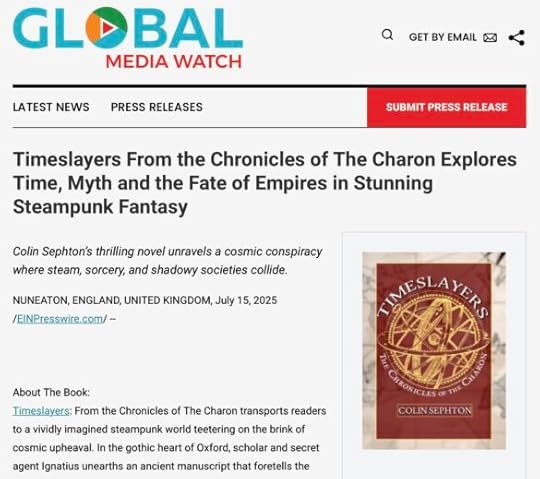
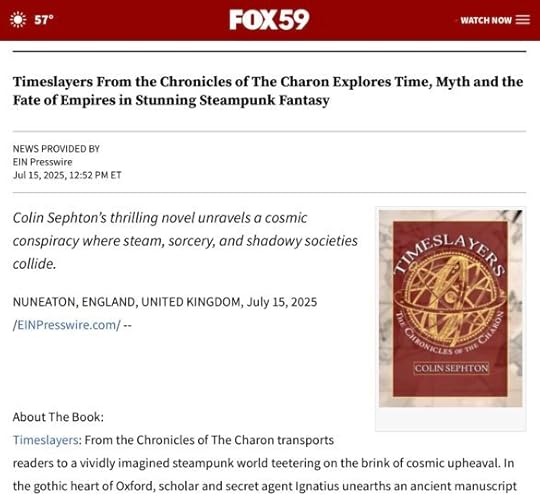
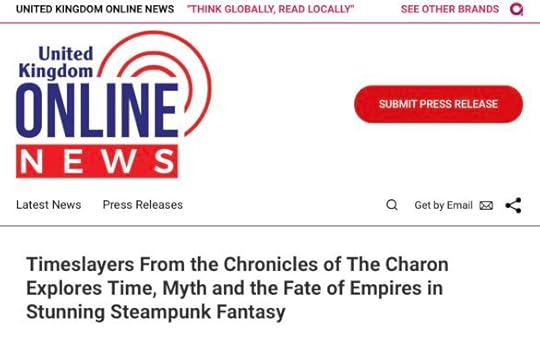
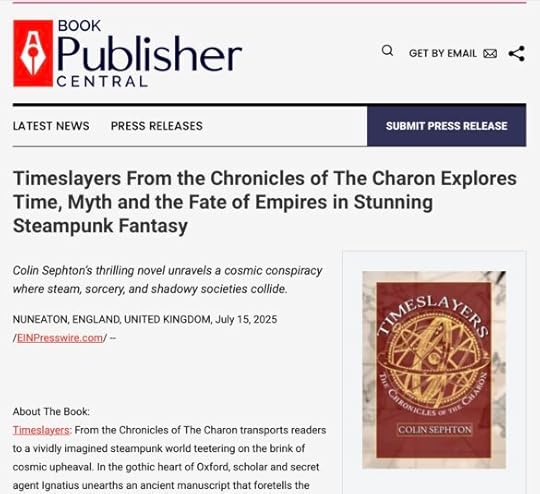
November 5, 2024
Timeslayers Review 3: What Happens When Proven Knowledge becomes Transformative?
Sephton���s novel shows that ultimate knowledge carries ultimate risk. The Book of Consciousness tempts scholars, curses bloodlines, and awakens ancient powers. Every page forces choices that blur morality, obsession, and survival. In Timeslayers, the pursuit of wisdom can destroy the seeker, reshape worlds, and turn hope into catastrophe.
The Book of Consciousness: Secrets, Curses, and the Fate of Empires in TimeslayersFantasy novels often revolve around objects of power���a sword, a crown, or a hidden relic. In Colin Sephton���s Timeslayers ��� From the Chronicles of the Charon, the most powerful object is not a weapon but a book. Known as the Book of Consciousness, or the Book of Turiya, it is the central thread that connects the Charon, the cursed bloodlines, and the struggles of those who seek knowledge. This book is more than parchment and ink; it is alive, shifting, and impossible to destroy. Its presence defines the story and reminds readers that knowledge, when forced open, can be as dangerous as any blade.
Origins of the Eternal Tome and Its MysteriesThe Book of Turiya is said to be written before the earth itself. Legends describe it as the only surviving artifact from a time when gods, spirits, and cosmic forces walked freely. Unlike human books, its pages cannot be cataloged or copied. They change, resist, and even burn the minds of those unworthy of reading them. From the start, it becomes clear that this book is not meant to be owned. It demands respect, patience, and balance. Its origin remains a mystery, yet its influence is undeniable. Wherever it appears, destruction and revelation soon follow.
Solomon���s Lifelong Obsession and Tragic DeathAmong all who sought the Book of Consciousness, none was more consumed than Solomon. A brilliant scholar, he believed unlocking the book would reveal the secrets of creation. For years, he tried everything���decoding runes, studying ancient languages, even using occult rituals. The book resisted him at every step. His hunger for truth transformed into madness, until finally, his obsession led to his death. Solomon���s fate is a warning written directly into the narrative. The pursuit of knowledge without humility destroys even the most brilliant minds. Through Solomon, Sephton shows that power cannot be seized without cost.
Skye���s Fatal Awakening of the CharonIf Solomon represents obsession, Skye represents desperation. Cursed by her Angevin bloodline, she saw the Book as her only hope. Unlike Solomon, she did not seek wisdom for its own sake���she wanted freedom. Yet her determination blinded her to the danger. When she forced the book open, she awakened not answers but horrors. The seven Charon, chained for centuries, were unleashed into the world. This act of desperation turned personal longing into a global nightmare. Skye���s choice is deeply human���who would not want release from suffering? Yet it shows how the wrong use of knowledge can collapse entire worlds.
The Symbol of the Book in Human HistoryBeyond the story���s surface, the Book of Consciousness mirrors humanity���s own history with knowledge. Across time, empires have risen and fallen because of how they treated wisdom. The secrecy of alchemists. By creating a living book that resists control, the author highlights that knowledge is not neutral. It shapes the future depending on how it is used. In this way, Timeslayers bridges fantasy with real-world reflection, reminding readers that the desire to know everything can become the very thing that destroys us.
When a Book Becomes More Dangerous Than a WeaponUnlike a sword or cannon, the Book of Turiya does not kill directly. Instead, it tempts, lures, and corrupts. Its danger lies in its ability to reshape consciousness itself. Those who read it begin to see differently, to feel differently, and to act with dangerous certainty. The Administorium, fearful of its influence, tried to suppress it. Yet suppression only made it more powerful, as seekers like Ignatius, Indigo, and Skye felt its pull even stronger. This echoes a truth we know well: forbidden knowledge always becomes the most tempting. The book���s danger is not only its content���it is its ability to change the reader.
The Larger Message Behind the TomeWhy does Sephton place such weight on a single book? The answer lies in the purpose of Timeslayers. The novel is not only about battles or machines. It is about the choices humanity makes when confronted with truths too heavy to bear. The Book of Turiya is a metaphor for every leap of progress in human history���each discovery offering both salvation and destruction. From fire to electricity, from steam to nuclear power, knowledge always asks the same question: What will you do with me? Through the Charon���s release, Sephton warns that using wisdom without responsibility leads to ruin.
Conclusion: Lessons from the Pages of TimeAt the heart of Timeslayers lies a paradox: knowledge can free us, yet it can also enslave us. The Book of Turiya embodies this tension. For Solomon, it was obsession. For Skye, it was a chance at freedom. For Ignatius and Indigo, it is both a burden and a call to responsibility. The book ties every character���s fate together while shaping the destiny of empires.
By focusing on this mysterious tome, Colin Sephton delivers more than fantasy���he offers a timeless lesson. Books can awaken worlds, but they can also unleash shadows. Timeslayers reminds us that the search for ultimate truth may not lead to light but to the very darkness we hope to escape.
October 5, 2024
Timeslayers Review 2: Is Power Found in Science, Magic, or Choice?
Dive into Colin Sephton���s Timeslayers, where steam engines clash with ancient curses and heroes face impossible decisions. Follow Ignatius, Indigo, and Skye as they battle shadowy forces, test the limits of invention, and confront the devastating cost of ambition. Will science, sorcery, or choice decide the fate of their world?
Between Shadows and Steel: Ignatius, Indigo, and Skye in TimeslayersColin Sephton���s Timeslayers ��� From the Chronicles of the Charon brings together fantasy and steampunk science in a way few novels manage. While the Charon and the Book of Turiya connect the story to timeless myths, steam engines, automata, and experimental technologies power the world around them. This combination of fantasy with science-driven imagination creates a vivid stage for the three central figures���Ignatius, Indigo, and Skye. Their paths show how fragile the line is between knowledge, loyalty, and destruction.
Ignatius and the Dangerous Search for KnowledgeIsambard Ignatius is introduced as a scholar, but his role goes far beyond quiet study. From the very beginning, he is drawn into dangerous manuscripts that whisper of the cosmos and its hidden rules. His birthmark, which tingles when he reads, signals that he is tied to something larger than human understanding. Ignatius stands at the meeting point between science and mysticism: he trusts engineering and logic, yet the texts he uncovers point to truths far beyond reason. This tension reflects the novel���s heart. In Ignatius, readers see both the promise of discovery and the peril of obsession.
Indigo Gemstone: A Warrior of Secrets and StrengthIf Ignatius represents knowledge, Indigo Gemstone embodies strength and resilience. Her life story is marked by family scandal, the mystery of her father���s disappearance, and her own choice to adopt a name that reflects independence. Indigo is more than a scholar of antiquities���she is a fencer, a strategist, and a survivor. In her, Sephton blends fantasy���s sense of heroic character with the steampunk flavor of a woman unafraid of technology and weapons. Whether walking Oxford���s shadowed streets or joining Ignatius in decoding ancient texts, she becomes both protector and partner in the quest against the darkness of the Charon.
Skye and the Curse of BloodWhile Ignatius and Indigo seek truth and protection, Skye moves in shadows. Her cursed Angevin bloodline makes her a tragic and unpredictable figure. Outwardly, she appears as an ally, willing to help the Union Jacks. Secretly, she hides darker desires: to use the Book of Consciousness for her own family���s freedom, regardless of the cost. Her involvement adds constant tension to the narrative. The fusion of occult rituals, runes, and her reckless energy tie her more closely to fantasy than science, yet she operates in the same Oxford that thrives on steam power and machinery. Her betrayal reminds us that technology may shape the world, but human choices still decide its fate.
The Union Jacks and the Science of EmpireAlongside personal struggles, Sephton introduces the Union Jacks���a hidden network of engineers and scientists sworn to protect the Empire. Unlike the Administorium, who resist change out of fear, the Union embraces progress, though carefully. Their world is filled with automata factories, airships, and rumors of Tesla-inspired weapons such as the Teleforce. These elements bring a distinctly sci-fi atmosphere to the story. Steam and steel exist side by side with mystical tomes and curses, making the Oxford of Timeslayers both familiar and otherworldly. The Union Jacks symbolize humanity���s drive to innovate while warning of the dangers of power unbalanced by responsibility.
When Machines Meet MythOne of the most striking qualities of Timeslayers is how science and myth collide. The Administorium fears not only the return of the Charon but also the rise of machines that could rival human consciousness. In the same world where curses bring forth ancient horrors, students of Tesla are experimenting with telautomatics���early forms of remote-controlled machines. This is not random decoration; it is central to the theme. Just as Skye���s choices unleash forces beyond her control, the Empire risks opening doors that technology cannot close. In Sephton���s vision, whether through steam cannons or mystical books, humanity is always reaching further than it can safely hold.
The Human Cost of PowerFor all its grand visions of hellfire, automata, and cosmic destiny, Timeslayers always returns to its characters. Ignatius suffers under the weight of knowledge he cannot fully understand. Indigo sacrifices comfort and safety to fight for balance in a world that shadows her every step. Skye, blinded by her curse, falls into ruin by seeking freedom through forbidden means. The blending of fantasy and sci-fi makes these struggles sharper: readers see both the dangers of lost myths and the risks of unchecked innovation. The cost of power is not abstract���it is written in the lives of those who reach for it.
Why Their Story MattersThe story of Ignatius, Indigo, and Skye is not just about good versus evil. It is about curiosity, loyalty, ambition, and betrayal in a world caught between steam-powered progress and ancient darkness. By weaving together the pulse of sci-fi with the weight of fantasy, Sephton creates a story that feels both unique and universal. Readers are invited to ask: How do we use the knowledge we discover? How do we balance progress with caution? And what happens when personal choices awaken forces larger than ourselves?
Conclusion: A Tale of Blended WorldsTimeslayers succeeds because it never limits itself to one genre. It is part fantasy epic, with cursed bloodlines, mystical books, and apocalyptic beings. It is also part sci-fi tale, with automata, airships, and the fear of machines gaining minds of their own. At the center stand Ignatius, Indigo, and Skye���three lives torn between knowledge, courage, and temptation. Through them, Sephton shows that whether we fight shadows of the past or build machines of the future, the struggle for balance never ends.
September 3, 2024
Timeslayers Review: Do the readers think it has hidden depth?
Timeslayers Review ��� From the Chronicles of the Charon is more than just another fantasy novel. It is a story that mixes myth, science, and human struggle into a single tale that feels both ancient and modern. Voted Fantasy Book of the Year 2024 by the Bookstagram Awards Community, the novel has gained attention because it does not only tell a story���it asks big questions about time, knowledge, and destiny. To understand its depth, we must explore the Charon, the Book of Turiya, and the characters who face choices bigger than themselves. This Timeslayers Review illustrates the intricate connections between time and the human experience.
The Origin of the Charon and Their Forgotten LegendIn this Timeslayers Review, we delve deeper into the impact of the Charon on the narrative and its themes.
The Charon are not simple shadows borrowed from mythology. In Greek stories, Charon is a single ferryman who guides souls across the River Styx. In Timeslayers, however, the Charon are far greater���seven unholy beings chained for centuries, waiting to be unleashed. They are both terrifying and fascinating, born from forgotten rituals and human mistakes. When they appear, they bring not only horror but also questions about power and balance. Their presence shows us how legends can grow into forces that still influence the present.
This Timeslayers Review also highlights how time itself plays a critical role in shaping the characters’ destinies.
How Time and Human Consciousness Shape the StoryUnlike many fantasy novels that focus only on battles or magic, Timeslayers digs deeper into the nature of time and the human mind. Ignatius, one of the main figures, discovers texts that suggest reality is not fixed. Instead, human consciousness shapes what happens across history. This idea threatens groups like the Administorium, who fear the loss of their control. Through Ignatius���s discoveries and Skye���s obsession with her cursed family line, Sephton shows that the greatest danger comes not from outside enemies but from humanity���s own thirst for forbidden knowledge. Time here is alive���it can be shaped, but it also punishes those who try to twist it.
The Book of Turiya, central to the Timeslayers Review, serves as a key to understanding the conflict and the Charon’s role.
Through these themes, this Timeslayers Review encourages readers to explore the moral implications of knowledge.
Ignatius, Indigo, and Skye���characters highlighted in this Timeslayers Review���represent the struggle between duty and darkness.
The Book of Turiya: Keeper of Eternal SecretsAs we examine the awakening of the Charon in this Timeslayers Review, we understand the consequences posed by their release.
This Timeslayers Review ties the eternal struggle back to the reader’s own life choices and the balance of knowledge and power.
At the center of the conflict lies the Book of Consciousness, also called the Book of Turiya. It is said to be older than the earth itself, indestructible, and alive in ways ordinary minds cannot understand. For Solomon, the scholar who spent his life studying it, the book became an obsession that consumed him. For Skye, it was a chance to free her bloodline from its curse. But opening the book meant opening the door to the Charon. The shifting pages reveal knowledge only when they choose, showing that wisdom cannot be forced. In this way, the book becomes a symbol for the novel���s theme: knowledge is powerful, but in the wrong hands, it destroys more than it saves.
Ultimately, this Timeslayers Review reflects on how the novel stands as a modern classic in fantasy literature.
Ignatius, Indigo, and Skye: Lives Torn Between Duty and DarknessFans of fantasy will find much to ponder in this Timeslayers Review, which acts as a reminder of the choices we face.
The cosmic struggle in Timeslayers feels real because it is tied to human characters who face inner battles. Ignatius is caught between curiosity and responsibility, searching for truth while fearing its cost. Indigo Gemstone represents strength shaped by mystery and personal loss, proving that loyalty and courage often come at a price. Skye, however, is perhaps the most tragic of all. Cursed by her bloodline, she longs for freedom but falls deeper into darkness as her desperation pushes her toward betrayal. Through them, Sephton shows that the war between light and shadow is not only in the heavens���it also burns inside the human heart.
The Awakening of the Charon and Its Terrifying ConsequencesThe turning point of the novel comes when Skye���s actions awaken the Charon. Their release is described in terrifying detail: rivers of blood, writhing forms, and monstrous beings that shift between beauty and horror. These scenes are not only meant to shock���they underline the danger of human obsession. The Charon are unleashed not by fate alone, but by choices made in desperation and arrogance. They remind us that civilizations can collapse when people lose balance between wisdom and ambition.
What the Eternal Struggle Means for Readers TodayAlthough the novel is set in a steampunk-inspired Oxford filled with airships, automata, and ancient tomes, its message reaches far beyond fantasy. It asks questions that matter even now: What happens when knowledge is pursued without wisdom? How do faith, science, and ambition shape our lives? And what shadows do we unleash when we chase power at any cost? The Charon are terrifying, but they are also mirrors, showing us what we can become when we forget balance and responsibility.
Timeslayers as a Modern Classic in Fantasy LiteratureWith its blend of myth, philosophy, and vivid storytelling, Timeslayers has secured its place as one of the most unique fantasy novels of recent years. The book���s award and recognition are proof of its impact, but its real strength lies in how it makes readers think beyond its pages. By exploring the Charon, the Book of Turiya, and the fragile choices of its characters, Colin Sephton has written more than a story of fantasy���he has created a reflection of human history, fear, and hope.
For fantasy and sci-fi fans, Timeslayers is more than just a tale to enjoy. It is a reminder that every age faces its own Charon, and that the choices we make decide whether light or darkness shapes our future.
May 5, 2024
Virtual Book Tour 2024 – Will the author answer your question?
https://its-raining-books.blogspot.com/search?q=Timeslayers
8th May 2024https://lisahaselton.com/2024/05/08/interview-with-fantasy-author-colin-sephton/?sfw=pass1757104727
9th May 2024https://fabulousandbrunette.blogspot.com/search?q=Sephton
10th May 2024https://sandrasbookclub.blogspot.com/2024/05/blog-tour-timeslayers-by-colin-sephton.html
https://goddessfishpromotions.blogspot.com/2024/03/vbt-timeslayers-by-colin-sephton.html




